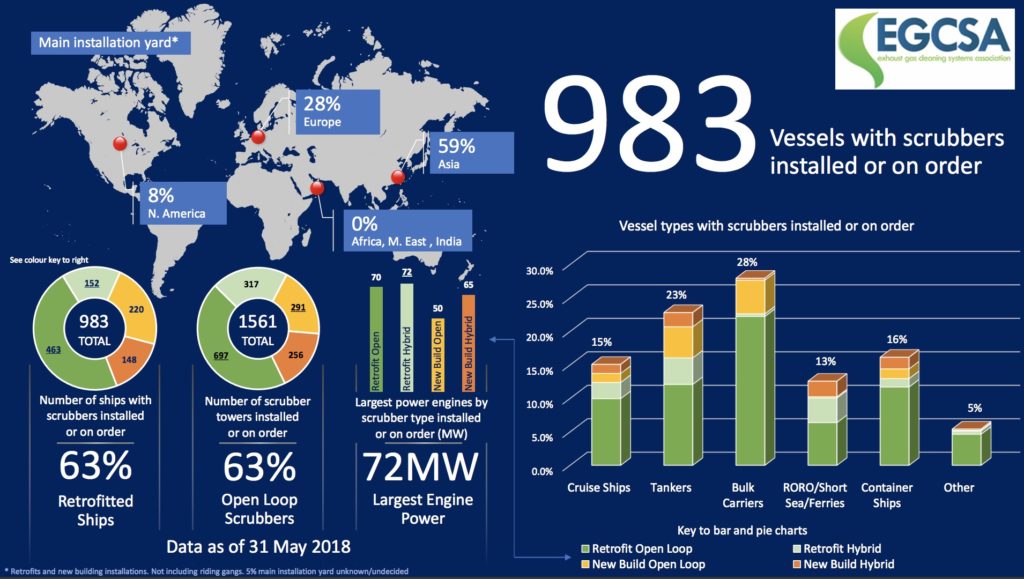A survey of EGCSA members has revealed that scrubber uptake is rapidly accelerating with the number of ships with exhaust gas cleaning systems installed or on order standing at 983 as of 31 May 2018
This follows a slew of recent reports that major ship operators, including Spliethoff, Frontline, DHT and Star Bulk have opted for scrubbers. One of the ‘big’ container companies has confirmed it will use scrubbing as part of its 2020 compliance portfolio and there are rumours that others will do likewise.

Until relatively recently the largest installed exhaust handling capacity has been for engine powers in the region of 25 to 30MW. However, the latest data shows that this has been well and truly exceeded by a retrofitted hybrid system for a 72MW container ship engine. Large capacity scrubbers are not confined to retrofits as the maximum size new building installation is a hybrid system for a 65MW engine.
Nearly 60% of all retrofits and new building installation works take place in Asian yards. Unsurprisingly this increases to nearly 85% of new building installs. EGCSA believes that although there has been a surge in demand, yard capacity is not an issue going forward, however other constraints such as the availability of laser scanning specialists and experienced installation teams mean that it may not be possible to pick and choose an installation slot nor coincide a scrubber installation with an already scheduled drydock in the near future.
Needless to say, the majority of EGCSA members are still taking orders with several now taking options through to 2023 to enable ship-owners to secure a position on the installation timetable.
Back in 2015 in readiness for the switch to 0.10% sulphur fuel, a number of RORO and ferry operators led the way and successfully chose scrubbers as a means of compliance. The cruise industry came next and now with 2020 looming, bulk carriers have taken over at the top of the ship types adopting exhaust gas cleaning, with container ships and tankers following. In each of these sectors retrofit open loop installations predominate.

The survey shows that 63% of all ships have either been or will be retrofitted with scrubbers, while 37% are new building installations. “
988 of the 1561 individual scrubber towers installed or on order are for open loop scrubbing; confirming it as the most popular exhaust gas cleaning system.
EGCSA is not surprised that open loop scrubbing is preferred. It is the simplest scrubbing system and favoured by ship crews. Although many early adopters in the North Sea and Baltic fitted hybrid systems, they are operated for the majority of time in open loop. Open loop scrubbing has also been used for years by coastal power stations and by oil tanker inert gas (IG) systems when in port without environmental issues.
While closed loop and hybrid systems are available for enclosed bodies of water with little water exchange or where discharges are restricted by local regulation, ECGSA suggests the alternative of switching to low sulphur fuel for the port stay where open loop operation is not possible. The cost impact is likely to be limited as over 90% of fuel consumption is during full away at sea, which is where the financial benefits really accrue.
Download a pdf of the EGCSA infographic with an overview of this data illustrated by scrubber type – retrofit open loop, retrofit hybrid, new build open loop and new build
